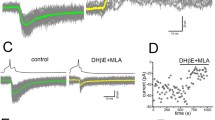Summary
-
1.
Non-rectifying electrotonic coupling was found among neurons which receive inhibitory or biphasic synaptic input from the characterised dopamine neuron inPlanorbis corneus. No coupling was found among neurons receiving excitatory input.
-
2.
There was wide variation in coupling between different neurons; coupling coefficients ranged from 0 to 0.5, and were not related to the proximity of the cell bodies.
-
3.
Input from the dopamine neuron, or application of dopamine reduced the strength of coupling.
-
4.
In some of the neurons the strength of coupling was increased by hyperpolarization; this appeared to result from the increase in input resistance with hyperpolarization shown by these particular neurons.
-
5.
The coupled neurons could produce recurrent burst activity by two different mechanisms: by interactions within the network or as a result of endogenous pacemaker potentials.
-
6.
Some of the implications of the coupling for analysis of data on transmission from the dopamine neuron are discussed.
Similar content being viewed by others
References
Asada, Y., Bennett, M.V.L.: Experimental alteration of coupling resistance at an electrotonic synapse. J. Cell Biol.49, 159–172 (1971)
Ascher, P.: Inhibitory and excitatory effects of dopamine onAplysia neurones. J. Physiol. (Lond.)225, 173–209 (1972)
Bennett, M.V.L.: Physiology of electrotonic junctions. Ann. N.Y. Acad. Sci.137, 509–539 (1966)
Bennett, M.V.L.: Flexibility and rigidity in electrotonically coupled systems. In: Synaptic transmission and neuronal interaction. Bennett, M.V.L. (ed.), pp. 153–178. New York: Raven Press 1974
Bennett, M.V.L., Grundfest, H.: Analysis of depolarizing and hyperpolarizing inactivation responses in gymnotid electro-plaques. J. Gen. Physiol.50, 141–169 (1966)
Berry, M.S.: A system of electrically coupled small cells in the buccal ganglia of the pond snail,Planorbis corneus. J. Exp. Biol.56, 621–637 (1972)
Berry, M.S., Cottrell, G.A.: Excitatory, inhibitory and biphasic synaptic potentials mediated by an identified dopamine-containing neurone. J. Physiol. (Lond.)244, 589–612 (1975)
Berry, M.S., Cottrell, G.A.: Ionic basis of different synaptic potentials mediated by an identified dopamine-containing neurone inPlanorbis. Proc. R. Soc. (Biol.)49, 427–444 (1979)
Berry, M.S., Pentreath, V.W.: Problems associated with the use of tetraethylammonium to test for monosynaptic connexions. J. Exp. Biol.62, 797–803 (1975)
Berry, M.S., Pentreath, V.W.: Criteria for distinguishing between monosynaptic and polysynaptic transmission. Brain Res.105, 1–20 (1976)
Berry, M.S., Pentreath, V.W.: The integrative properties of electrotonic synapses. Comp. Biochem. Physiol.57 A, 289–295 (1977)
Berry, M.S., Pentreath, V.W.: The characterised dopamine neuron inPlanorbis corneus. In: The biochemistry of characterised neurons. Osborne, N.N. (ed.), pp. 81–115. Oxford: Pergamon 1978
Carew, T.J., Kandel, E.R.: Two functional effects of decreased-conduc tance e.p.s.p.s: synaptic augmentation and increased electrotonic coupling. Science192, 150–153 (1976)
Getting, P.A., Willows, A.O.D.: Burst formation in electrically coupled neurons. Brain Res.63, 424–429 (1973)
Getting, P.A., Willows, A.O.D.: Modification of neuron properties by electrotonic synapses. 2. Burst formation by electrotonic synapses. J. Neurophysiol.37, 858–868 (1974)
Grundfest, H.: Ionic mechanisms in electrogenesis. Ann. N.Y. Acad. Sci.94, 405–457 (1961)
Hutter, O.F., Warner, A.E.: The voltage dependence of the chloride conductance of frog muscle. J. Physiol. (Lond.)227, 275–290 (1972)
Kandel, E.R., Tauc, L.: Anomalous rectification in the metacere-bral giant cells and its consequences for synaptic transmission. J. Physiol. (Lond.)183, 287–304 (1966)
Kater, S.B.: Feeding inHelisoma trivolvis: the morphological and physiological bases of a fixed action pattern. Am. Zool.14, 1017–1036 (1974)
Kehoe, J.S.: Ionic mechanisms of a two-component cholinergic inhibition inAplysia neurones. J. Physiol. (Lond.)225, 85–114 (1972)
Levitan, H., Tauc, L., Segundo, J.P.: Electrical transmission among neurons in the buccal ganglion of a mollusc,Navanax inermis. J. Gen. Physiol.55, 484–496 (1970)
Pentreath, V.W., Berry, M.S.: Ultrastructure of the terminals of an identified dopamine-containing neurone marked by intracellular injection of radioactive dopamine. J. Neurocytol.4, 249–260 (1975)
Pentreath, V.W., Berry, M.S.: Ethanol induces bursting amongst electrically coupled snail neurones. J. Pharm. Pharmacol.30, 321–323 (1978)
Spira, M.E., Bennett, M.V.L.: Synaptic control of electrotonic coupling between neurons. Brain Res.37, 294–300 (1972)
Author information
Authors and Affiliations
Additional information
Part of this work was supported by a grant from the Medical Research Council to Dr. G.A. Cottrell.
Rights and permissions
About this article
Cite this article
Berry, M.S., Pentreath, V.W. Electrotonic coupling among postsynaptic neurons of the characterised dopamine neuron inPlanorbis . J. Comp. Physiol. 131, 267–275 (1979). https://doi.org/10.1007/BF00610434
Accepted:
Issue Date:
DOI: https://doi.org/10.1007/BF00610434




